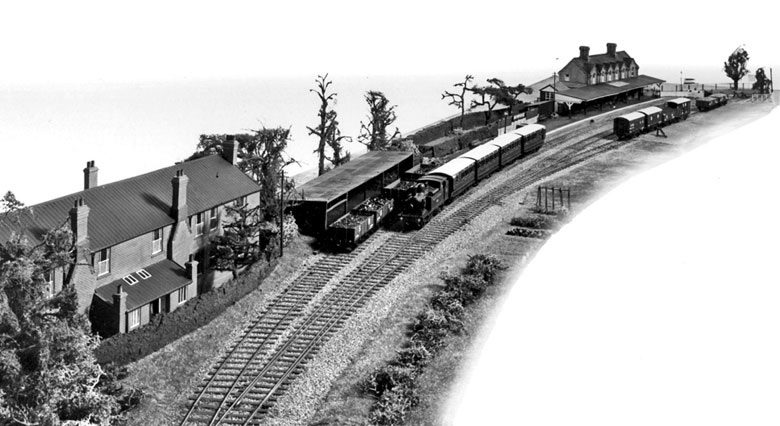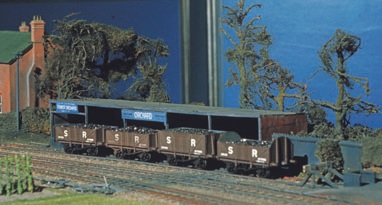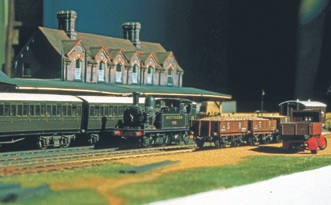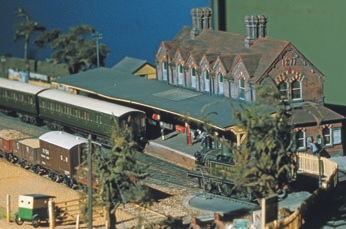The following article was originally published in Scalefour News 188.

BEMBRIDGE was the first privately-owned layout to be built at the Model Railway Club (MRC) headquarters at Keen House, and during its exhibition lifetime between 1971 and 1985 it was always attributed to “Members of the Model Railway Club”, a group of five in fact.
The advent of Protofour had provided the stimulus to build a detailed model of a prototype station as it had been in its pre-war heyday. All five members of the group were Southern enthusiasts, and as two members were particularly interested in the railways in the Isle of Wight, one of the stations on the island seemed an obvious choice.

Bembridge, terminus of a short branch from Brading, had closed in 1953, but one member of the group had measured all the trackwork before it had been lifted in 1958. The track layout at the real Bembridge was built on a gentle curve and the pointwork, and connection to the turntable, just flowed one into another; nowhere in the track layout was there any ‘natural break’ which might allow for a baseboard split. It was this flowing track work which meant that the prototype could only be faithfully copied if the track gauge was absolutely to scale. That was why it took the advent of P4 to make it possible, it couldn’t be done even in EM. In 1969 the station buildings were fortunately still relatively intact and it proved possible to create a full set of working drawings – just in time as it turned out, for by 1971 a row of houses occupied the site.

The planning and construction of the layout occupied eighteen months, using many (for the time) experimental state-of-the-art features, such as a spine-backed curvilinear baseboard. With assistance from Dick Ganderton and Ken Cottle, trackwork was made up using Studiolith components on a cork base, with finelygraded sand representing the prototype’s shingle ballast. Buildings, fences and much of the detail of the scenery were built using Slater’s Plastikard, a material that – despite some initial misgivings – proved ideal for the intricate brickwork and shaped roof tiles of the Victorian station building.

Most items of rolling stock were scratchbuilt. (Although the O2 class tank locomotives were constructed using Wills – now Southeast Finecast – whitemetal kits, a member of the group had created the masters from which they were cast). Several small rolling stock components were manufactured specially for the group and subsequently became available commercially. The group also produced the intricate panelled body sides of one carriage set by commissioned photo etching, a process then little used outside the printing industry. The adoption of Alex Jackson couplings facilitated hands-free operation.

Bembridge was first shown to the public at the MRC annual exhibition at the Central Hall, Westminster at Easter 1971, and was then famously chosen to represent the best of British modelling at the American NMRA’s National Convention when that was held in central London in the summer of the same year. It returned to the MRC Easter show slightly extended and with a new sector-plate fiddleyard in 1974, and its last show was at the Club’s 75th anniversary exhibition at Wembley in 1985.

One of the odd results of operating Bembridge was the occasional incidence of wagons (uncompensated in those days) derailing on the point for the goods yard siding. Several years later, one of the group (doing his day job) came across an old Southern Railway diagram for Bembridge and alongside the point for the goods yard siding was pencilled a list of wagon numbers known to have derailed on it – the geometry of the real thing, faithfully copied on the model, was faulty!

The colour detail photographs accompanying this article were taken at Central Hall, Easter 1974 (Ian Lyle, copyright Janet Lyle)
David Woodcock adds the following photo, saying “Cutting out the letters for the name board was an interesting task, and that fence is an accurate rendering of the real thing too”

